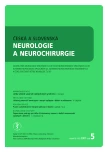Importance of the S100B protein Assessment in Patients with Isolated Brain Injury
Authors:
P. Lavička 1; R. Pikner 2; S. Kormunda 3; O. Topolčan 2; R. Bosman 4; I. Chytra 4; L. Holubec 2; M. Choc 1
Authors‘ workplace:
Neurochirurgické oddělení LF UK a FN, Plzeň
1; Oddělení nukleární medicíny, úsek imunodiagnostiky, LF UK a FN, Plzeň
2; Ústav sociálního lékařství LF UK a FN, Plzeň
3; Anesteziologicko-resuscitační klinika LF UK a FN, Plzeň
4
Published in:
Cesk Slov Neurol N 2007; 70/103(5): 521-526
Category:
Original Paper
Tato práce byla podpořena grantem IGA MZ NR 7874-3/2004
Overview
Objective:
The objective of the study was to assess the importance of S100B protein in patients with CNS injury for clinical practice.
The method:
The study included 98 patients who were admitted to the Teaching Hospital of Pilsen from January 2004 to June 2006 due to isolated head injury. Generally used scoring protocols were used to evaluate the clinical status of the patients upon admittance and release, i.e. the Glasgow Coma Scale (CGS), APACHE II, Injury Severity Score (ISS) and Trauma Revised Injury Severity Score (TRISS) upon admittance, and the Glasgow Outcome Scale (GOS) upon release. The values of S100B protein were measured upon admittance and after 6, 12, 24 and 72 hours. The level of S100B protein was measured with the use of the Liaison immunoanalyser, DiaSorin, Italy.
Results:
We proved the relation between the absolute values of the S100B protein levels at all the times observed and the resulting clinical status for the patient sample we monitored. Best related to the resulting clinical status is the S100B protein value 24 hours after admittance (r = –0,540, p<0.0001). The value of 100B protein after at 24 hours over 1.17 μg/l means 12.8 times higher risk of negative resulting clinical status (p<0.0001) A drop in the level below 0.2 μg/l within 72 hours post-admittance is, on the contrary, associated with a 92% probability of a satisfactory clinical status.
Conclusion:
In practice, dynamic monitoring of S100B values of protein can be recommended, the most significant being the level 24 hours post-admittance, while the values below 0.2 μg/l predict a good resulting clinical status of the patient. With values over 0.2 μg/l, it is necessary to follow the level at 72 hours.
Key words:
S100B protein – isolated head injury – CT finding – Glasgow Coma Scale – ISS – TRISS – Glasgow Outcome Scale – resulting clinical status
Sources
1. Heizmann CW, Fritz G, Schafer BW. S100 proteins: Structure, functions and pathology Front Biosci 2002; 7: d1356-1368.
2. Raabe A, Grolms C, Sorge O, Zimmermann M. Serum S-100B protein in Severe Head Injury. Neurosurgery 1999; 45: 477-4783.
3. Rothoerl RD, Woertgen C, Holschuh M, Metz C, Brawanski A. S-100 Serum Levels after Minor and Major Head injury. J Trauma 1995; 45: 765-767.
4. Woertgen C, Rothoerl RD, Brawanski A. Early S-100B serum level correlates to quality of life in patiens after severe head injury. Brain Injury 2002; 16: 807-816.
5. Biberthaler P, Mussack T, Wiedemann E, Kanz K-G, Koelch M, Gipper-Steppert C et al. Evaluation of S100b as a specific marker for neuronal damage due to minor head trauma. World J Surg 2001; 25: 93-7.
6. Ingebrigtsen T, Romner B, Marup-Jensen S, Dons M, Lundqvist C, Kellner J et al. The clinical value of serum S-100 protein measurements in minor head injury: a Scandinavian multicentre study. Brain Injury 2000; 14: 1047-1055.
7. Zimmer DB, Cornwall EH, Landar A, Song W. The S100 protein family: history, function, and expression. Brain Res Bull 1995; 37: 417–429.
8. Cocchia D, Michetti F, Donato R. S100 antigen in normal human skin. Nature 1981; 294: 85–87.
9. Donato R. Perspectives in S100 protein biology. Cell Calcium 1991; 12: 713–26.
10. Kleindienst A, Ross Bulock M. A critical analysis of the role of the neurothropic protein S100B in acute brain injury. J Neurotrauma 2006; 23: 1185-2000.
11. Korfias S, Stranjalis G, Papadimitriou A, Psachoulia C, Daskalakis G, Antsaklis D et al. Serum S-100B protein as a biochemical marker of brain injury: a review of current concepts. Curr Med Chem 2006; 13: 3719-3731.
12. Townend WJ, Guy MJ, Pani MA, Martin B, Yates DW. Head injury outcome prediction in the emergency department:a role for protein S100B. J Neurol Neurosurg Psychiatry 2002; 73: 542-546.
13. Vos PE, Lamers KJ, Hendriks JC, van Haaren M, Beems T, Zimmermann C et al. Glial and neuronal proteins in serum predict outcome after severe traumatic brain injury. Neurology 2004; 62: 1303-1310.
14. Raabe A, Kopetsch O, Woszczyk A, Lang J, Berlach R, Zimmermann M et al. S100B protein as a serum marker of secondary neurological complications in neurocritical care patiens. Neurol Res 2004; 26: 440-445.
15. Townend W, Dibble C, Abid K, Vail A, Sherwood R, Leckz F. Rapid elimination of protein S-100B from serum after minor head trauma. J Neurotrauma 2006; 23: 149-155.
16. Dimopoulou I, Korfias S, Dafni U, Anthi A, Psachoulia C, Jullien G et al. Protein S-100b serum levels in trauma-induced brain death. Neurology 2003; 60: 947-951.
Labels
Paediatric neurology Neurosurgery NeurologyArticle was published in
Czech and Slovak Neurology and Neurosurgery

2007 Issue 5
Most read in this issue
- Treatment of Epileptic Syndromes in Children
- Assesment of Optic Disc Edema
- Are some of the contraindications for lumbar punction outdated today? A Case Report
- Transforaminal lumbar interbody fusion (TLIF) and instruments. Prospective study with the minimum of 20-month follow-up
